Reactive Dog Training: Tips To Help Your Dog Get Better
May 18, 2023 2023-05-22 15:52Reactive Dog Training: Tips To Help Your Dog Get Better
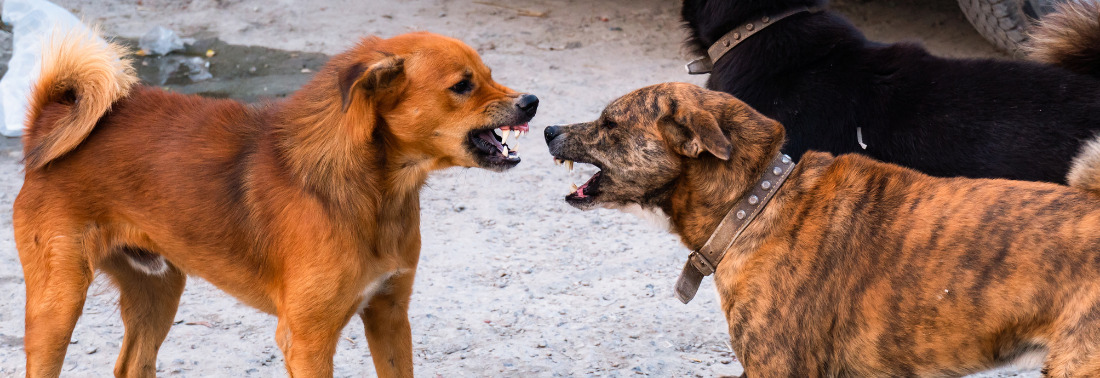
Reactive Dog Training:
Tips To Help Your Dog Get Better
Table of Contents
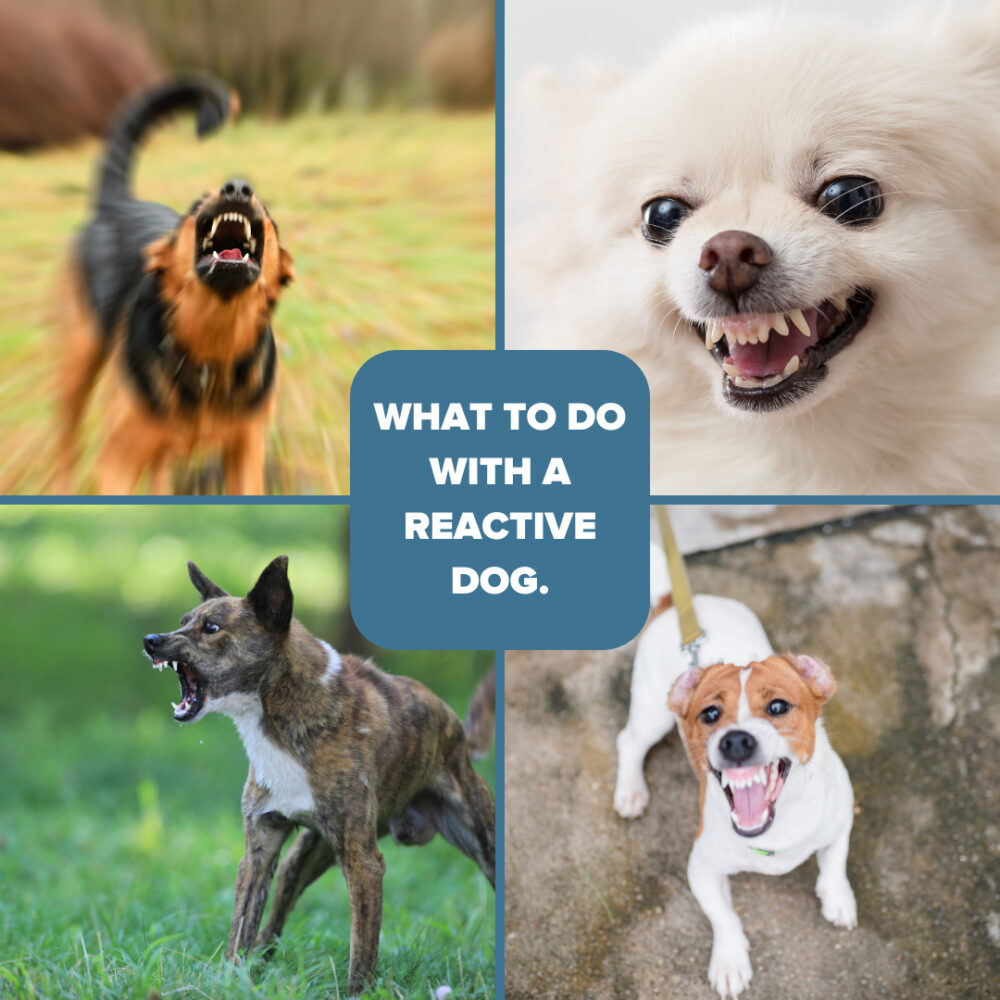
Having a reactive dog can be a huge burden. Not being able to walk him without worry because he is showing leash reactivity, not being able to go to the park, not being able to take him to a fun group training class; and always having to watch out for potential critical encounters is wearing and stressful. Maybe your dog is actually really good at training and you would love to participate in dog sports, but the reactivity is holding you back. And you wonder: How can you introduce your reactive dog to another dog?
Modern dog training has given us the tools and knowledge on how to reduce and at times even eradicate reactivity in dogs. By understanding dog behavior and where it stems from, we can devise a training plan.It is not too late to start training your reactive dog!
Read on to get to know my opinions and solutions for reactive dogs – and why I think they do have a chance for recovery!
I have used the methods described many times with fantastic outcomes on my clients’ dogs. Many went from being quite reactive dogs and having to be separated at all times to being able to peacefully coexist. Sometimes they even form friendships with other dogs.
Here are the top 3 reasons your dog can and will get better!
Reactive Dogs Are Uncomfortable
A lot of reactivity originates in discomfort. Even though it may look like our dog is “protective” of us (likely not) or “dominance-aggressive” (also likely not), the most plausible and common reason for his behavior is that he is not happy to be where he is, stressed and (often) scared.
Like humans, some dogs choose to retreat, and some choose to just go for the outright confrontation when faced with a situation that makes them anxious.
This does not mean they actually wants to attack the other dog in front of them – it just seems the only viable option for our dogs.
Especially if your reactive dog is on a leash, it is likely that they will decide on what appears like a dominant-aggressive charging of other dogs, when in fact they just perceives it as the last resort solution to take care of a threatening situation. Your dog reacts to it in the best (and only way) they know: by choosing to be the first to attack.
We cannot cure this discomfort by scolding our dog. In fact, scolding them for showing stress through barking, lunging or growling is only going to make them more anxious.
In their mind, if you scold them, then the situation probably is really critical!
Instead, always maintain a calm and collected attitude when your dog gets scared and reacts unfriendly. take their leash and move away from the situation until they are more relaxed and happy again.
But, of course on the long run we want to not only prevent our dog from lashing out at another dog – we want to change their reaction all together!
And here is how we do it:
Helping A Reactive Dog Find Calm
Fortunately, there is not only a possible, but in fact very straight-forward way to address negative emotions.
Psychology has taught us how we can alter feelings that are linked to a certain situation.
For your reactive dog, these are the emotions of profound stress and anxiety when faced with another dog.
Right now, your dog shows reactivity because the trigger (frequently another dog) elicits these feelings in them. We can however change these feelings to a calm, neutral and even happy state of mind.
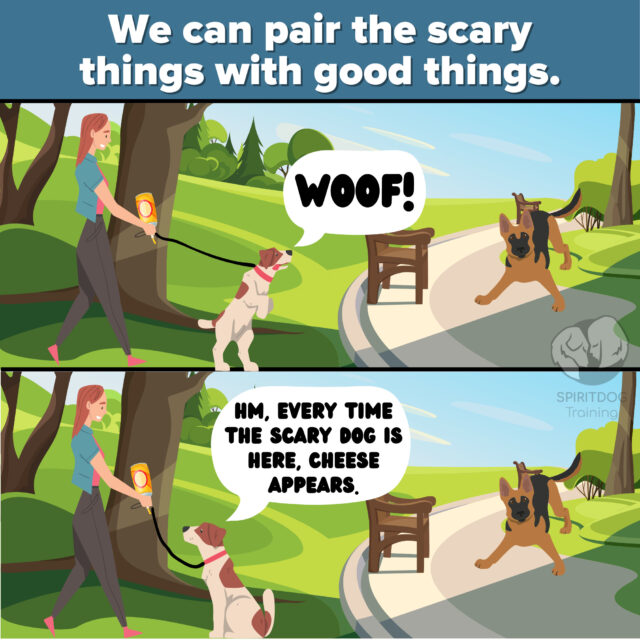
If we give our dog something awesome every time they see a trigger, they will eventually understand that the trigger predicts the appearance of awesome things.
What is awesome to a dog? Food of course. Most of all, delicious food.
Pick a really fantastic treat. Steak or chicken or cheese. Freeze-dried raw food or fresh food such as FreshPet. Make sure that it is very special to them.
You can choose an extra special food that you don’t use in any context other than working on reactivity. The clearer we can make it for our dog, the better.
Set yourself up in a situation in which you can be prepared. Maybe you can ask your friend to come over with their dog and stay at a certain distance, or you can set yourself up at a distance to a dog park. Then, as soon as your dog sees another dog, start feeding them the special treats.
Have the triggering dog leave the situation. Now you also have to stop feeding your dog. We want to make it very obvious to them that only the scary other dog can make the favorite food appear!
Repeat this as often as possible.
Start at large distances and work your way up to being close to the other dog over time. We never want our dog to feel overly stressed or anxious during this process.
If your dog is so on edge that they will not eat your treats anymore, you need to increase the distance. The brain can only learn if the stress level is not too high.
If we go over this certain critical stress level, all our dog will remember is his fear. Always stay under this stress level and do not push your dog too far too quickly.
It comes with the danger of actually setting our dog back.
It is better to go slow and wait a little longer – this is too important of a behavior to rush and skip training steps!
Dog Reactivity Chart
Here is our SpiritDog reactivity chart. Refer to it whenever you are approaching a trigger that would make your dog show a reactive response.
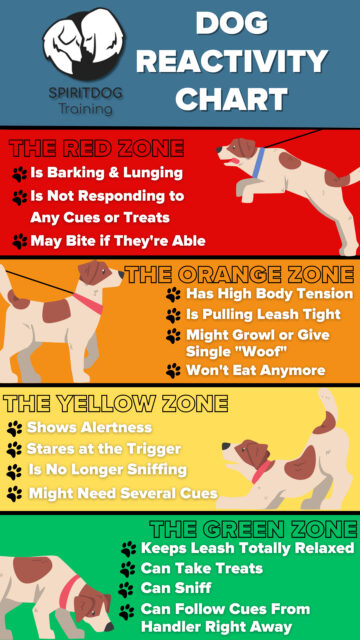
Let’s look at the different zones in the chart.
Your reactive dog’s ideal mindset is in the green zone. Whenever possible, they should be able to sniff, take your treats, follow your cues right away and keep their leash completely relaxed. A reactive dog that is far enough from their threshold does not look reactive at all. This is important to keep in mind! You should not push your dog to have an explosive response.
If your dog is in the yellow zone of the reactivity chart, they may still be able to train relatively successfully. Small amounts of stress are not counterproductive. The key here is the word “small” – your dog should still be able to take treats from you. They should not be straining towards the trigger.
A dog in the orange zone in our reactivity chart is just moments away from “blowing up”. This is not a state of mind in which your dog can make new, positive memories. All they are going to remember is the stress. You should get out of there while you still can!
Finally, a dog in the red zone has escalated their reaction. They are not able to respond to or even acknowledge any cues from the hander. They are lunging, barking and might even consider to bite if pushed too far.
Why Is My Dog Becoming More Reactive?
Have you experienced that your dog is becoming more reactive as time goes on? Maybe you have tried to use different techniques to reduce their reactive responses, but they seem to escalate and “go crazy” faster and faster. The reason for this might be that your dog spends too much time in the orange phase in our reactivity chart.
Watch out for these signs:
- Rigid body
- Stiff tail (the tail might be straight up in the air and could even be wagging)
- Stare that you cannot interrupt
- Dog is unable to respond to easy cues (such as their name, Come or Sit)
- Dog is straining on the leash
If you see your dog display these behaviors frequently on walks, they are too stressed to become less reactive. Putting them into situations like this over and over will only make the reactivity worse.
What Are The Most Reactive/Aggressive Dog Breeds?
It needs to be noted that reactivity and aggression are not one and the same behavior. Reactivity can often become aggression. Every breed can produce reactive dogs, but they certainly are more prevalent in some than in others. In order to understand which breeds are the most reactive, we need to look at their origin.
All breeds except toy breeds (such as Cavachons) were originally bred to perform a certain task. The specific requirements of this task determine their behavior to a large extend.
Herding dogs such as Border Collies or Heelers were developed to spend their days in solitude, surrounded only by sheep. Our modern herding dogs’ ancestors never socialized with large groups of people or dogs.
Other dogs were bred to be guard dogs, such as the King Shepherd. They as well were not developed to be social butterflies. Now that we keep many of these previously hardworking dogs as pets, their original function and current use collide.
In my work with reactive dogs, I have found that Australian Shepherds and German Shepherds are the breeds that owners experience the most reactivity with. These breeds are very popular and wide-spread.
Due to their breed-specific tendencies, reactivity can creep up quickly and owners often are overwhelmed when it comes to working on it.
How To Use Your Dog Reactivity Chart
When you go on a walk with your dog, take the chart along and work on their reactivity. Make sure that they stay in the green and yellow zone. As soon as your dog approaches the orange zone, you need to abort and move out of the way of the trigger.
Sometimes it can be tricky to use the reactivity chart if you live in a busy area. In this case you should pick a time to walk your dog when nobody else is out. For some dogs with deeply ingrained reactivity, walks need to be stopped.
The best way to work on reactivity in safe settings is to set up specifically designed reactivity sessions. Ask a friend and their dog to meet you in an open area, or select a park or walking trail with dogs and stay at a distance. Approach the trigger from very far away while giving your dog treats and letting them sniff the ground. Make sure the leash is loose and your dog is relaxed.
Check on your reactivity chart: Is your dog still in the yellow or green zone? If not, you need to increase the distance to their trigger. This is the only way to effectively change their response in the long run.
If The Dog You’re Walking Is Barking At Another Dog, What Should You Do?
Sometimes reactivity can surprise you out of nowhere. Your dog may have been fine around other dogs so far and now suddenly reacts intensely on a walk. They are lunging and growling … and you wonder what you should do if they are barking at another dog? You try to tell them to stop and sit, but it is not helping.
Refer back to the reactivity chart at the top of this page: Your dog is in the red zone! No wonder that they are unresponsive and don’t do as you ask them to. It is crucially important that you turn around and walk away briskly as quickly as possible.
Every second that your dogs spends in the red zone can do some damage. As a dog trainer, I can tell you right now that there is nothing you can realistically do to “snap your dog out of it”. You can either stay where you are, futilely trying to control your dog – or you can move them out of the zone!
Reactive Dog Training Tips
Why is it so important to keep that critical distance to your dog’s trigger? Why should they not “flip out”?
The reason is that our brains are programmed to only remember fear, stress and negative associations from threatening situations. From an evolutionary perspective, this makes a lot of sense!
Imagine a dog being chased by a bear and just barely escaping.
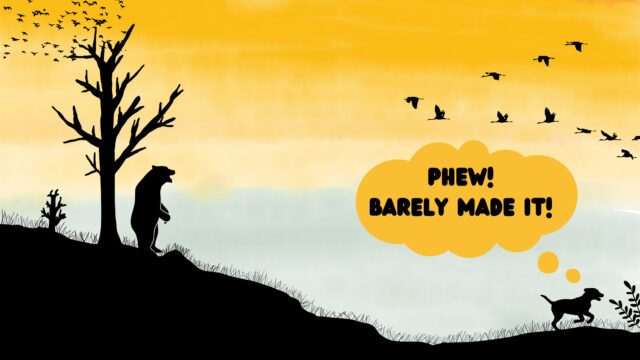
Even though the outcome was positive, the dog needs to remember the negative event and be very scared and ready to run fast again the next time they encounter a bear.
They should by no means learn “Oh, I escaped and it wasn’t so bad. Next time I just won’t try as hard.”
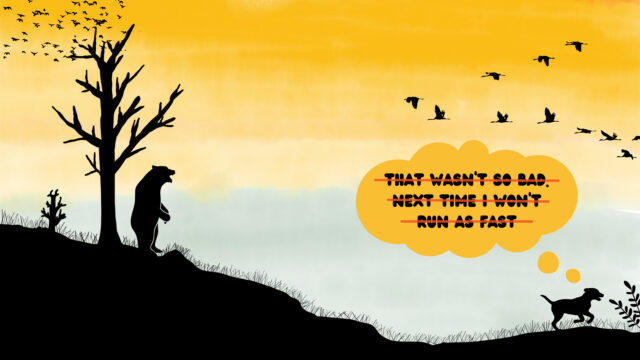
Being too positive about stressful events is not smart. The dog needs to learn that this was super scary and they will be even more anxious next time.
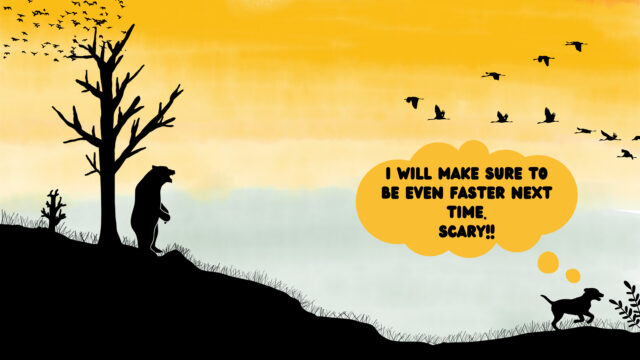
Therefore, your reactive dog must never feel “as if they are chased by a bear”. If you approach the trigger too closely, they will not be able to make any lasting, positive associations in the training session.
Always keep your dog from “losing it”. A barking, lunging dog is not the right state of mind to make positive memories.
Being proactive in setting up your training sessions so that your dog does not cross his threshold should always be the #1 goal for every training.
Don’t give up hope!
Reactivity is never fun. Thankfully, you can change your dog’s feelings towards other dogs. Remember that no person or dog enjoys being scared. If you can show your dog a way to be happier and more relaxed, they will gladly accept it.
Until then, management can be your friend!
Here are some management ideas. Hang in there – it is not easy to own a reactive dog and you are doing great work every day!
Training Reactive Dogs – vs Management
What is management, anyway? What makes it different from training?
Training – obviously – is aimed at changing a dog’s behavior on the long run. In our case, this might mean counterconditioning/desensitization. Training is a longer process and we rarely see immediate results in behavior modification. The goal of training is to get the dog to a point at which they do not require much guidance or outside help anymore to deal with certain situations – we want to have changed their behavior in a way that it will always be appropriate.
Training takes time, and during that time we still want to keep everyone safe. We also want to make sure that the way our dog experiences the world does not make them even more suspicious of it!
Here is where management comes into play. Management in dog training refers to the process of setting up the dog’s environment in a way that makes good behavior likely. If a puppy chews on shoes, you can put the shoes away. While this does not teach them to stop chewing on shoes (that would be training), it achieves the same result for the moment: No more shoes are damaged.
Or – if they have trouble settling at night, you put your puppy into his crate with a delicious bone.
For an anxious and stressed dog it is crucially important to have proper management in place. Otherwise they might escalate a situation that is scary for them in the worst case. In the best case they will not be able to advance in training as quickly as they could. Smart management can help them feel as comfortable and happy as possible and go hand in hand with training.
Let’s look at how we can manage can keep everyone happy and safe.
Leash-Reactive Dog Training

This one may seem counterintuitive. You have a reactive dog, the last thing you want to do it to put them on a long line for sure?
Actually, the opposite is true. By having our reactive dogs on a short leash, we can easily increase their stress as they are not able to use body language the way they usually would.
As we sense a potential tigger approach, we tend to wrap the leash around our wrist or hold it high up in the air, further restricting our dog’s movement and making them feel like there is only one way out of the situation: outright attack.
If you are at a distance to a trigger at which your pup is already lunging and going crazy, you are too close in any way – long line or not. Ideally, you want to always keep your dog at a distance at which they are under the threshold – meaning not stressed enough to “go wild” and not be able to listen to you or take treats anymore.
So since you want to keep a healthy distance in any case, while you are at this distance your dog might really benefit from being at a long leash that allows him to sniff and move his body naturally without restrictions.
Chewing As A Therapy
Of course we want the majority of our pup’s life to be not stressful at all. The goal should always be to have the dog not in an anxious state during as much time as possible. You can think of it as a general way of improving their life by providing them with as much calm and happy time as possible.
One way to give them relaxed, content downtime is by providing plenty of appropriate chew items.
Often I ask clients “Does your pup have chew toys?” and they say yes and show me a collection of torn-apart stuffed animals and rope toys.
These are not appropriate chew toys.
If your dog enjoys chewing, please do not let them chew on anything that is made out of fabric (or, for that matter, plastic, wood etc.). They are not meant to ingest these materials and while most of the time they will probably be fine, if your dog does happen to get a blockage this will be both dangerous and expensive to treat.
Instead, let them chew on items that are made out of animal parts. Here are my personal favorites:
- Kongs
Kongs are fantastic refillable chew toys. Use your favorite recipe to fill them and freeze to make them a go-to canine popsicle.
For any reactive or stressed dog I recommend to make sure you have a few frozen Kongs ready to go at any point in time, so you never run out!
- Beef Hooves
If you have a sensitive nose, these might not be your favorite. Once a dog has thoroughly chewed on a cow hoof, it starts to smell quite intensely.
If you are not sensitive to smells or if you have an outside area where your dog can enjoy his cow hoof though, go for it!
Cow hooves can be found in any feed store for less than $1 and provide long-lasting chewing fun for your dog.
- Bully Sticks
I have yet to meet a dog who does not love bully sticks. While they are not the cheapest chew item out there, they do last at least an hour for most medium-sized dogs (and many hours for smaller dogs) and make them very, very happy. One of my doggy day training clients in Albuquerque always has a bully stick ready for me to give to the dog when I leave. The dog used to be quite distressed about my departure and I could hear her crying from the outside as I went to my car. Since we introduced the ritual of giving the bully stick, this is a thing of the past. The dog already runs to the cupboard with the bully sticks when she sees me getting ready to leave and eagerly awaits her treat. Then she is happily chewing as I leave and not anxious anymore.
What To Avoid
Here are some chew items you want to avoid, or at least be careful about:
- Nylabones
These are plastic chew toys “infused” with some taste, like chicken, bacon or peanut butter. Unfortunately, these toys win in neither tastiness nor safety: On the one hand, many dogs abandon their Nylabones after a few tries since they seem to not thoroughly enjoy the taste. On the other hand, a heavy chewer might well be able to slowly chip away and ingest the plastic of a Nylabone, which again is definitely not what your dog should be eating.
- Rawhides
Rawhides are great chew articles as long as your dog is not consuming larger amounts of them. If you have a heavy chewer who easily eats a whole retriever roll within minutes, you should refrain from giving him rawhides. The safest way to have your dog enjoy rawhides is to only give them to the dog for a little while and then allow them to dry before the next round. - Any Kind Of Artificial Toy
As already mentioned, please do not give any kind of non-animal matter to your dog to ingest. This includes tennis balls, knotted rope toys, stuffed animals, soft rubber toys and similar items.
I once had the shock of my life when a pet sitter told me she let a dog chew and eat a whole frisbee throughout the cause of a night.
If your dog has trouble giving up items that he should not chew or eat (such as clothing, shoes, toys), read here how to prevent resource guarding and teach him that it is ok to give his treasures back to you.
Sniff Walks
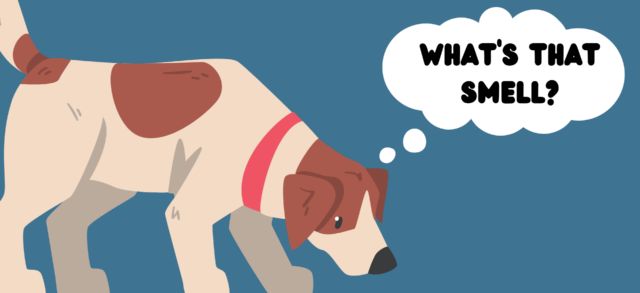
Many aggressive dogs do not feel entirely sure and confident about their surroundings. Once they have shown us reactivity we are vigilant to keep them under control and allow them as little access as possible to situations that might become stressful for us and them.
Sadly this often goes along with reduced walks and outside adventures. Dogs really benefit from being walked and love to sniff. If at all possible, try to find situations in which you can allow your dog to take a sniff walk.
Sniffing will let them feel more informed and therefore confident about their environment. It also is a naturally calming activity – one that in fact dogs often seek out by themselves to diffuse potentially tricky situations!
In my neighborhood lives a quite reactive older dog. His owners take him on two sniff walks every day – one early in the morning and one late at night. That way they avoid the other dogs who are walking while at the same time giving the senior time to sniff everything in detail. He loves his sniff walks – I often watch him from our living room window in the mornings slowly walking and gently wagging his tail as he takes it all in with his nose.
Mental Exercise

If your dog is struggling with unwanted behavior like this, providing appropriate physical exercise can be difficult as you cannot let your them off-leash, take them to dog parks, to your neighborhood park or even to a doggy daycare.
Thankfully, it is not just physical exertion tires dogs out – but also mental one. Reactive dogs can really benefit from being challenged to think carefully and solve puzzles with smartness rather than force.
Here are some ideas:
- Names Of Rooms
Have your dog in one room of your house and hide a treat (or toy) in another one. Get them, bring them to the room with the treat and show it to them. As you are doing this, tell them what the room is called.
Do this with just one room at first – they will quickly understand to rush to this room when you tell them to and get the treat. Over time, gradually add the other rooms of your house. Eventually you can tell your dog the name of any room and they will know where to go!
- Hidden Treats
Hide treats with a variety of objects. You can out them under towels, under plastic cups, under turned-over cardboard boxes, in paper towel rolls, in plastic lunch boxes with the lid partially closed etc. Let them work out how to solve these puzzles.
I recommend to not go straight to the next puzzle once your dog has solved one. Instead, I usually present the same puzzle to them multiple times. Often dogs are able to for example tip over a cup and eat the treat underneath it once after a couple tries, but when you set up the game again they are as clueless as in their very first attempt.
Always repeating the puzzles teaches them to pay attention to their problem solving strategy and to make an effort to remember it as they will need it again!
I find that this even carries over to other areas of training, such as trick training or obedience. Dogs that have experience in solving puzzles multiple times tend to memorize new behaviors quicker.
Routine Building
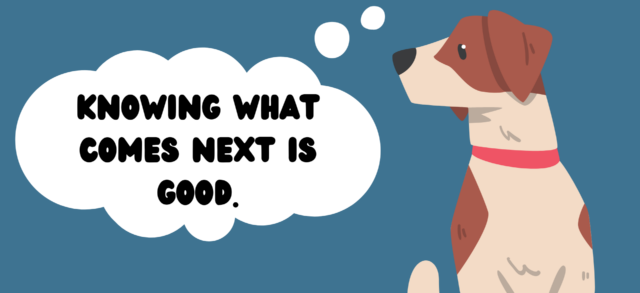
Reactivity often goes along with feeling uncertain. If our dogs perceive a situation as out of their control, completely new and unknown it can make them feel uncomfortable and anxious.
While we cannot guarantee that our dogs will never be in a novel situation, we can try to make sure that even if they are in a new place, they will always have something they know.
By this “something” I do not mean a toy to play with or a mat to lie on – after all, we might forget these one day – but a trick routine that the dog practices until they are really good at it and can do it in their sleep.
These tricks should be neither boring nor especially challenging. Do not pick a 2 minute Sit Stay as part of your routine or balancing on a small wooden beam that your dog can barely stand on. After all, we want to make sure he has a good time and is enjoying himself!
Some tricks that work great for routine building are:
- Spin Left And Right
This trick is not only very easy and fun, but also intuitive for many dogs! Your dog may already spin when they are excited or expecting something good happening, such as when you come home from work or right before mealtimes. You can put it on a cue and use it for your fun routine!
If your dog does not naturally spin yet, you can lure them in a circle with a cookie in front of his nose. Make sure that you lure them right at the level of the nose and not too high up. If your dog only moves their head or sits down, your cookie is probably too high up or you are moving it too quickly.
- Hand Touch
In this trick your dog touches their nose to your palm. It is a great behavior for getting your dog’s attention. They cannot be distracted by anything if they are touching their nose to your hand!
It is also a trick that dogs often are able to do when everything else fails. My Border Collies for example, especially one of them, can get stuck in a “Border Collie freeze” – snapping into their herding mode in which they move very slowly or not at all and are not able to respond to cues such as sit, down etc.
No matter how stuck, mine are always able to do a hand touch!
- Paws Up
Teach your dog to put their front paws up onto an elevated object while their hind feet stay on the ground. This can be a bench, a curbside, a rock…the more creative you can be and the more objects your dog can practice this on, the better! Use the same cue for all objects to help your dog generalize.
This can also be helpful for dogs who are struggling a bit with new and unknown surfaces. While jumping up on a strange surface with all four feet is too committing for shy and unsure dogs, they often feel brave enough to put their front feet on.
- Paws Up Side Stepping
This is an advanced version of Paws Up. If your dog has been doing well with the last trick, you can now stand facing them and move very slowly to the side. You can have a cookie in your hand to lure your dog as you are doing this. They have to move laterally. This is not a movement they do a lot in daily life so you want to be patient, move in small steps and reward any efforts generously!
- Jump Over Leg
Teach your dog to jump over your leg. You can start out sitting on the ground to prevent them from “cheating” by slipping underneath your leg. Put your foot against a barrier of some sort (such as a wall, a couch, a tree etc.) and toss a cookie over your leg so that your dog has to jump over to get it.
Over time you can raise your leg more and more and move away from the barrier.
Now that you have a repertoire of tricks, put them into an order. This could for example be spin left, spin right, hand touch, paws up on the nearest object and jump over your leg as a finish.
Keep that order – we want to make sure our dog always knows what comes next and can rely on this in any environment and situation. Dogs actually are extremely good at learning behavior chains and remembering what even long series of tricks.
If you get bored over time with your routine and your dog has learned new tricks, you can add them onto your existing chain!
Finding The #1 Hobby
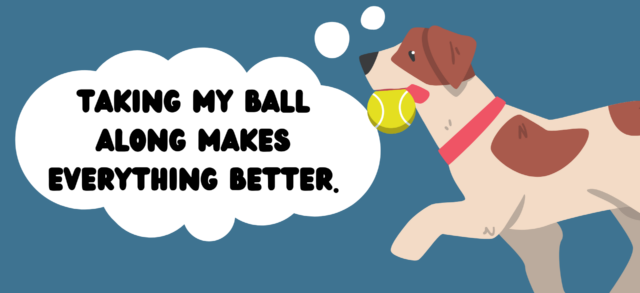
Some reactive dogs can forget everything around them when they are focused on an activity they really love. For many dogs, this is playing with a specific toy – most commonly balls or frisbees.
If your dogs loves to chase and fetch, use this activity to your advantage as much as possible.
The more time your dog can spend being “in the zone” and pursuing his favorite activity, the better. Often this can later help the dog transition to being around the things that he is reactive to. Let’s for example look at playing frisbee:
Helping By Playing Frisbee
The following has worked for several of my clients who have dogs that are extremely fond of playing frisbee. (If your dog does not love toys quite yet, try out this method to make them love playing)
You want to start out playing in a safe space far away from anything that your dog might react to. For many owners, this is their own yard. But even if you don’t have a yard you might be able to find a place that is not frequented by too many people or dogs, such as a school yard in the late evening (make sure you are allowed to use it first of course), an open space that is not very busy etc.
Begin by just playing with your dog there. As always, you want to make sure you follow the rules of playing and training:
- Don’t Overdo It.
As a rule of thumb you can assume that your dog will start the next session with the mindset they left the last one with. That means that if you play until your dog has had enough and wanders of to sniff the bushes nearby, you went too far. Instead aim for them to look at you demanding and maybe even be a bit frustrated that your session ended when you call it quits. If you stop when they are still going at 110%, this will be the attitude that he will begin the next playtime with!
- Always Be Fun.
It is tempting to scold our dogs when they don’t pay attention, don’t fetch as well as we would like them to or stop the game because they seem much more interested in peeing on everything nearby than playing.
Keep in mind that you want to make this playtime fun for your dog, in fact you want to make it the funnest thing in his life. This will not be successful if you are nagging or scolding them.
Instead, be as upbeat, friendly and happy as possible and your dog will repay it with much more engagement than if you get annoyed at them!
- Pick Your Dog’s Happy Hour.
All dogs have times of the day during which they are more awake and alert than others. For many, these happy hours are in the morning and in the evening. If your dog ever gets the zoomies, jumps at you for attention or seems to be restless, this is a great time to put this energy to good use by playing.
It is not ideal to wake your dog up from a nap and start playing with a still half-asleep pup. Instead, wait for them to show you that they are ready to go and have some fun!
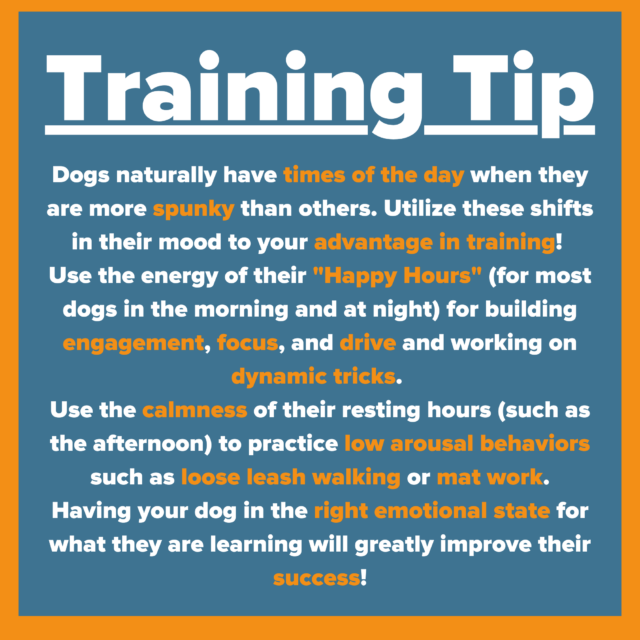
After you have played enough in the remote location that your dog gets the crazy look in his eyes whenever they see their frisbees, you can move to a slightly more crowded place. This could for example be a park.
Make absolutely sure that you have physical control of them by attaching a long line to them so they cannot take off and get into trouble.
Of course, the long line is only there for safety – we do not want to approach any people or dogs so closely that our dog gets worked up enough to charge to the end of the leash.
Now you play with them just like you did in your prior location. Pay attention to being connected to them the whole time – we do not want to give them too much opportunity to look around and potentially get worried about what’s there. For some dogs, it can be really useful to get them out of the car, run to the place where you will play and then play for five minutes. After the time is up (and your dog is still interested in playing), race back to your vehicle.
Over time, your dog will start to associate the fun they have with you and his frisbee to the park and perhaps even the people and/or dogs in the distance that they used to feel uneasy about. At the very least they will learn that he can have fun and a good time in public, and that it is possible to ignore and tune out everything that might bother them for his frisbee.
A Word At The End
Owning a reactive dog is never easy. Doing your best to keep everyone safe, help your dog work on the reactivity and still have some fun downtime can be a challenge for everyone.
If you are encountering this challenge, know that you are doing great, no matter which step of the journey you are on.
Dog-Reactivity: FAQ
Is reactivity breed-specific?
While a dog of any breed can develop reactivity, we mostly see it in high-strung herding breeds or guard dogs.
Dog breeds in which reactivity is common are Australian Shepherds, Heelers, German Shepherds and crosses of those breeds.
Can my adult reactive dog be cured?
Dogs of any age can start training to improve their reactivity. You do need to keep in mind that the longer a behavior has been ingrained, the longer it will take to retrain the dog.
Whether or not the dog will be “cured” in the sense of being completely fine in the presence of his triggers cannot be predicted. However, all dogs can make significant improvements with the right training approach.
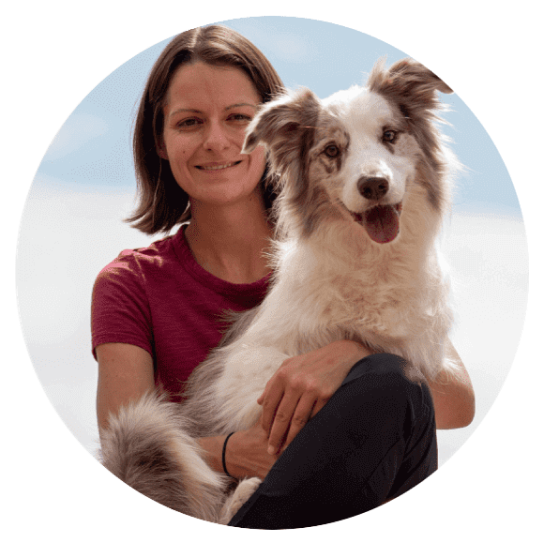
Author: Steffi Trott
Steffi Trott is the head trainer at SpiritDog Training. Steffi specializes in dog cognition and behavior and she’s been teaching dog training to thousands of clients both locally and through online lessons, since 2013. She studied dog training with European trainers such as multi-world champions in agility and European Open winners Silvia Trkman, Polona Bonac, Martina Klimesova and Anna Hinze as well as US trainers like Kim Terrill and Daisy Peel.

